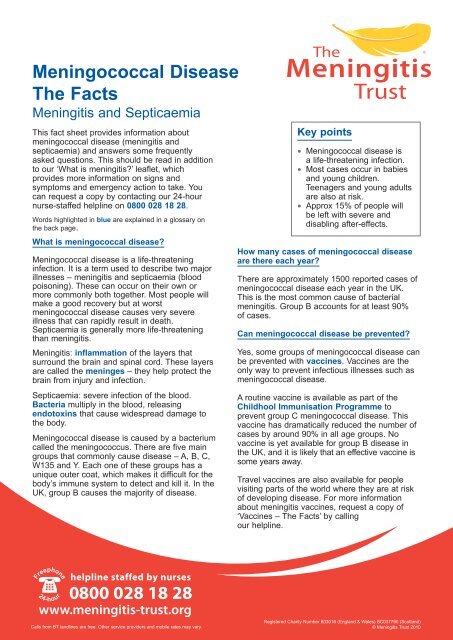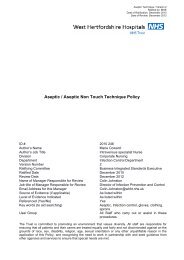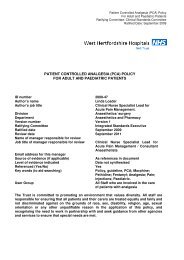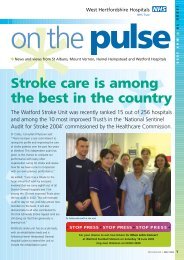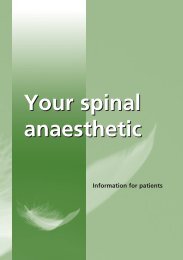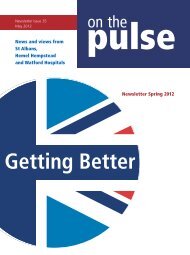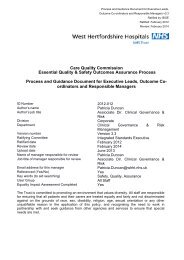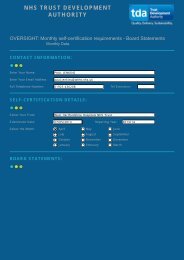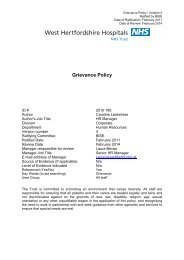Meningococcal Disease patient information leaflet - West ...
Meningococcal Disease patient information leaflet - West ...
Meningococcal Disease patient information leaflet - West ...
Create successful ePaper yourself
Turn your PDF publications into a flip-book with our unique Google optimized e-Paper software.
<strong>Meningococcal</strong> <strong>Disease</strong><br />
The Facts<br />
Meningitis and Septicaemia<br />
This fact sheet provides <strong>information</strong> about<br />
meningococcal disease (meningitis and<br />
septicaemia) and answers some frequently<br />
asked questions. This should be read in addition<br />
to our ‘What is meningitis’ <strong>leaflet</strong>, which<br />
provides more <strong>information</strong> on signs and<br />
symptoms and emergency action to take. You<br />
can request a copy by contacting our 24-hour<br />
nurse-staffed helpline on 0800 028 18 28.<br />
Words highlighted in blue are explained in a glossary on<br />
the back page.<br />
What is meningococcal disease<br />
<strong>Meningococcal</strong> disease is a life-threatening<br />
infection. It is a term used to describe two major<br />
illnesses – meningitis and septicaemia (blood<br />
poisoning). These can occur on their own or<br />
more commonly both together. Most people will<br />
make a good recovery but at worst<br />
meningococcal disease causes very severe<br />
illness that can rapidly result in death.<br />
Septicaemia is generally more life-threatening<br />
than meningitis.<br />
Meningitis: inflammation of the layers that<br />
surround the brain and spinal cord. These layers<br />
are called the meninges – they help protect the<br />
brain from injury and infection.<br />
Septicaemia: severe infection of the blood.<br />
Bacteria multiply in the blood, releasing<br />
endotoxins that cause widespread damage to<br />
the body.<br />
<strong>Meningococcal</strong> disease is caused by a bacterium<br />
called the meningococcus. There are five main<br />
groups that commonly cause disease – A, B, C,<br />
W135 and Y. Each one of these groups has a<br />
unique outer coat, which makes it difficult for the<br />
body’s immune system to detect and kill it. In the<br />
UK, group B causes the majority of disease.<br />
Key points<br />
• <strong>Meningococcal</strong> disease is<br />
a life-threatening infection.<br />
• Most cases occur in babies<br />
and young children.<br />
Teenagers and young adults<br />
are also at risk.<br />
• Approx 15% of people will<br />
be left with severe and<br />
disabling after-effects.<br />
How many cases of meningococcal disease<br />
are there each year<br />
There are approximately 1500 reported cases of<br />
meningococcal disease each year in the UK.<br />
This is the most common cause of bacterial<br />
meningitis. Group B accounts for at least 90%<br />
of cases.<br />
Can meningococcal disease be prevented<br />
Yes, some groups of meningococcal disease can<br />
be prevented with vaccines. Vaccines are the<br />
only way to prevent infectious illnesses such as<br />
meningococcal disease.<br />
A routine vaccine is available as part of the<br />
Childhool Immunisation Programme to<br />
prevent group C meningococcal disease. This<br />
vaccine has dramatically reduced the number of<br />
cases by around 90% in all age groups. No<br />
vaccine is yet available for group B disease in<br />
the UK, and it is likely that an effective vaccine is<br />
some years away.<br />
Travel vaccines are also available for people<br />
visiting parts of the world where they are at risk<br />
of developing disease. For more <strong>information</strong><br />
about meningitis vaccines, request a copy of<br />
‘Vaccines – The Facts’ by calling<br />
our helpline.<br />
Freephone<br />
24-hour<br />
helpline staffed by nurses<br />
0800 028 18 28<br />
www.meningitis-trust.org<br />
Calls from BT landlines are free. Other service providers and mobile rates may vary.<br />
Registered Charity Number 803016 (England & Wales) SC037790 (Scotland)<br />
© Meningitis Trust 2010
Who gets meningococcal disease and why<br />
<strong>Meningococcal</strong> disease can affect anyone of any<br />
age, but young children and particularly babies<br />
under the age of one are most at risk.<br />
Both adults and children can carry<br />
meningococcal bacteria harmlessly in the back<br />
of the throat. Around 10% of the general<br />
population will be carriers at any given time and<br />
nearly everyone develops immunity as a result<br />
of carrying these germs. Bacteria are passed<br />
from person to person by coughing, sneezing<br />
and intimate kissing.<br />
Babies and young children are more at risk<br />
because their body’s defences are not fully<br />
developed. If the bacteria invade the body their<br />
immune system cannot provide resistance to<br />
fight off infection. A risk factor for teenagers and<br />
young adults is increased social interaction; this<br />
increases the number of carriers to around 30%.<br />
What happens in the body<br />
Occasionally meningococcal bacteria defeat the<br />
body’s defences and cause infection. The<br />
bacteria break through the lining of the back of<br />
the throat and pass into the bloodstream. Here<br />
they start to multiply rapidly, doubling in number<br />
around every 30 minutes. They can travel in the<br />
bloodstream to infect the meninges, causing<br />
meningitis, or whilst in the bloodstream they can<br />
cause septicaemia.<br />
<strong>Meningococcal</strong> meningitis<br />
When the bacteria infect the meninges, the<br />
blood vessels in the lining of the brain are<br />
damaged. This allows the bacteria to break<br />
through and infect the cerebrospinal fluid<br />
(CSF), the meninges become inflamed and<br />
pressure around the brain can cause nerve<br />
damage. Pressure on the brain can produce the<br />
specific symptoms associated with meningitis,<br />
such as:<br />
• Severe headache<br />
• Dislike of bright lights (photophobia)<br />
• Neck stiffness<br />
• Nausea and vomiting<br />
• Confusion and drowsiness<br />
• Loss of consciousness<br />
• Fitting<br />
<strong>Meningococcal</strong> septicaemia<br />
As the bacteria multiply rapidly in the bloodstream,<br />
they begin to release endotoxins from their outer<br />
coating. The body’s natural defences have little<br />
effect on these poisons and eventually blood<br />
vessels become damaged. This results in the more<br />
specific symptoms of septicaemia:<br />
• Fever with cold hands and feet<br />
• Joint or muscle pain<br />
• Rapid breathing<br />
• Stomach cramps and diarrhoea<br />
• Red/purple spots or bruises that do not fade<br />
under pressure<br />
As septicaemia advances, it affects the whole body<br />
and can cause organ damage or failure. The rash<br />
associated with septicaemia is caused by blood<br />
leaking into the tissues under the skin.<br />
Many other symptoms can occur with<br />
meningococcal disease. You can request a<br />
symptoms card by calling our helpline on<br />
0800 028 18 28.<br />
How is meningococcal disease treated<br />
<strong>Meningococcal</strong> meningitis and septicaemia need<br />
urgent treatment with antibiotics and rapid<br />
admission to hospital. If treated promptly,<br />
meningitis and septicaemia are less likely to<br />
become life-threatening. Whilst in hospital other<br />
treatment, procedures and investigations will be<br />
carried out depending on the <strong>patient</strong>’s condition.<br />
One of the main investigations carried out to test if<br />
someone has meningitis is a lumbar puncture.<br />
This allows the doctor to quickly make a diagnosis<br />
of meningitis by analysing the CSF that bathes the<br />
meninges. This fluid becomes infected when a<br />
<strong>patient</strong> has meningitis. Sometimes treatment with<br />
antibiotics is started because the <strong>patient</strong>’s<br />
condition is too serious for a lumbar puncture to be<br />
performed. In these cases the lumbar puncture can<br />
be done when the <strong>patient</strong>’s condition has<br />
improved.<br />
If someone is seriously ill, they will require<br />
specialist care and treatment in an intensive care<br />
unit. Here the doctors and nurses can closely<br />
monitor their condition, respond to emergencies<br />
and provide immediate support when it is needed.<br />
Appropriate hospital care and treatment are<br />
essential if the <strong>patient</strong> is to make a good recovery.
What happens when there is a case<br />
Management of meningococcal disease in the<br />
community is the responsibility of a doctor who<br />
specialises in the public health management of<br />
infectious diseases. The public health team<br />
(doctors and nurses) will visit the <strong>patient</strong> and their<br />
family in hospital in order to identify close<br />
contacts; these include household family members<br />
and intimate kissing contacts. Close contacts may<br />
be given antibiotics in order to reduce the risk of<br />
further cases. The antibiotics will kill any<br />
meningococcal bacteria being carried in the back<br />
of the throat, reducing the risk of further<br />
transmission. Close contacts may also be offered<br />
vaccination if a vaccine preventable group has<br />
been identified.<br />
If two or more cases of meningococcal disease<br />
occur within four weeks of the first case,<br />
preventative treatment may be offered to more<br />
distant contacts. Each situation will be individually<br />
assessed and appropriate action taken. For<br />
example, if a second case occurs within four<br />
weeks in the same nursery school, all children and<br />
staff will be offered antibiotics, and vaccination if<br />
appropriate.<br />
Most cases of meningococcal disease occur alone<br />
and the likelihood of a second related case is<br />
extremely small.<br />
It is vital that accurate <strong>information</strong> is given<br />
following a case of meningococcal disease, as it<br />
can cause a high level of anxiety and fear. The<br />
public health team will liaise with local GPs,<br />
relevant schools/nurseries or places of work to<br />
ensure good communication between all those<br />
concerned.<br />
What happens after meningococcal disease<br />
Most people who get meningococcal disease<br />
make a full physical recovery, but around 15% will<br />
be left with severe and often permanent<br />
disabilities. However, the exact number of people<br />
who experience after-effects is not known.<br />
The after-effects of meningitis usually happen<br />
because of damage to various areas of the brain,<br />
including the nerves responsible for hearing and<br />
sight. The serious and disabling after-effects are<br />
well recognised and include hearing loss or<br />
deafness, loss of vision or blindness, epilepsy,<br />
severe brain damage, speech problems, learning<br />
difficulties and behaviour problems.<br />
After-effects and complications of septicaemia<br />
occur as a result of damage to the major organs of<br />
the body such as the brain, kidneys, lungs, heart<br />
and skin.<br />
The toxins in the blood damage vessels and stop<br />
the vital flow of oxygen to the organs including<br />
the skin and underlying tissues. After-effects<br />
include areas of scarring, loss of digits or limbs<br />
and organ damage.<br />
After-effects are often complicated and can<br />
require ongoing support (for life) from a wide<br />
range of health professionals and organisations.<br />
In many cases the after-effects will be helped by<br />
various kinds of therapy, for example,<br />
physiotherapy and occupational therapy.<br />
Other people may experience one or more of a<br />
wide range of less debilitating but serious aftereffects.<br />
These can be temporary or permanent<br />
and include memory loss, anxiety, depression and<br />
headaches. Whatever the after-effect, mild or<br />
severe, meningitis can change a person's life<br />
forever.<br />
Tragically, some <strong>patient</strong>s will die despite receiving<br />
the best possible treatment and care. The death<br />
of a loved one following meningitis or septicaemia<br />
is always painful and traumatic. If you have lost a<br />
loved one, our trained helpline staff are available<br />
24 hours a day, and can explain how we may be<br />
able to offer you support.<br />
More detailed <strong>information</strong> about the after-effects<br />
of meningitis is available in our ‘After meningitis’<br />
booklet. You can request a copy by contacting our<br />
helpline on 0800 028 18 28.<br />
Find out more<br />
• Meningitis Trust<br />
www.meningitis-trust.org<br />
Information about meningitis and the work of<br />
the Meningitis Trust.<br />
www.meningitis-learning.org<br />
Learn more about meningitis by playing online<br />
quizzes and touring the virtual body invasion.<br />
• NHS Immunisation <strong>information</strong><br />
www.immunisation.nhs.uk<br />
Information about vaccination published by<br />
the Department of Health.<br />
• Meningitis a Guide for Families (1997)<br />
J Simon Kroll, Andrew J Pollard, Parviz Habibi<br />
–Publisher, Publishing Solutions Ltd (UK).<br />
A recommended read for parents. This book<br />
provides excellent <strong>information</strong> and uses<br />
case studies to explain meningitis and<br />
meningococcal disease.<br />
• Need to know meningitis (2004)<br />
Kristina Routh – Publisher, Heinemann<br />
Library. This comprehensive and easy to<br />
understand book traces the history, incidence<br />
and consequences of meningitis.
Glossary<br />
Bacteria/bacterium<br />
Single-celled micro-organisms, of which there<br />
are many types. Some types can cause<br />
disease in humans. One organism is called a<br />
bacterium, whilst more than one are called<br />
bacteria.<br />
Cerebrospinal Fluid (CSF)<br />
A protective fluid that flows around the brain<br />
and spinal cord, helping to maintain healthy<br />
cells.<br />
Childhood Immunisation Programme<br />
A planned programme of vaccines available<br />
to all children, which protects them from a<br />
range of infectious diseases. For more<br />
<strong>information</strong>, visit www.immunisation.nhs.uk.<br />
Endotoxins<br />
Poisonous proteins contained in the cell walls<br />
of some micro-organisms e.g. bacteria.<br />
These poisons are released when the<br />
bacteria die and cause widespread damage<br />
to body tissues and organs.<br />
Immunity / immune response<br />
The body’s ability to recognise and resist<br />
specific infectious diseases. The immune<br />
system responds to infection by producing<br />
antibodies.<br />
Inflammation<br />
A response of the body tissues to injury or<br />
irritation. The response is characterised by<br />
redness, swelling, heat and pain.<br />
Lumbar puncture<br />
A procedure to remove CSF from around the<br />
spinal cord.<br />
Meninges<br />
The protective membranes that surround the<br />
brain. These are called the dura mater,<br />
arachnoid mater and pia mater.<br />
Vaccine / vaccination<br />
An injection given to encourage the body to<br />
produce antibodies which help to fight<br />
infectious disease. The injection contains<br />
small particles of the disease-causing<br />
organism.<br />
The Meningitis Trust<br />
We, the Meningitis Trust, are a registered charity<br />
set up in 1986 by families who had been affected<br />
by meningitis. We are committed to increasing<br />
understanding of the disease and providing<br />
specialised professional services to anyone who<br />
has been affected. These services offer<br />
emotional, practical and financial support to help<br />
people rebuild their lives.<br />
Here are some of the ways we do this.<br />
24-hour helpline – a Freephone service, staffed<br />
by nurses, providing <strong>information</strong> and support<br />
seven days a week<br />
Home visits – trained staff offer <strong>information</strong> and<br />
support in people’s homes<br />
Art therapy – allows children and young adults<br />
to use art to help them express how they are<br />
feeling in safe and confidential surroundings<br />
Professional counselling – confidential<br />
counselling for people who have had meningitis<br />
and their families<br />
Financial support grants – to help fund<br />
specialist training, equipment, activities, respite<br />
care (to give carers a break from caring) and<br />
funeral costs<br />
One-to-one contacts – putting people affected<br />
by meningitis in touch with volunteers who have<br />
also experienced the disease<br />
This is only made possible by donations from<br />
people like you, as we rely almost entirely on<br />
voluntary support to fund our work.<br />
If you have any questions or wish to discuss<br />
anything in this fact sheet in more detail,<br />
please phone our helpline.<br />
Freephone<br />
24-hour<br />
helpline staffed by nurses<br />
0800 028 18 28<br />
www.meningitis-trust.org<br />
Calls from BT landlines are free. Other service providers and mobile rates may vary.<br />
Head office Fern House Bath Road<br />
Stroud Gloucestershire GL5 3TJ UK<br />
Phone: 01453 768000 Fax: 01453 768001<br />
Registered charity number 803016 (England & Wales) SC037790 (Scotland)<br />
©Meningitis Trust January 2010


